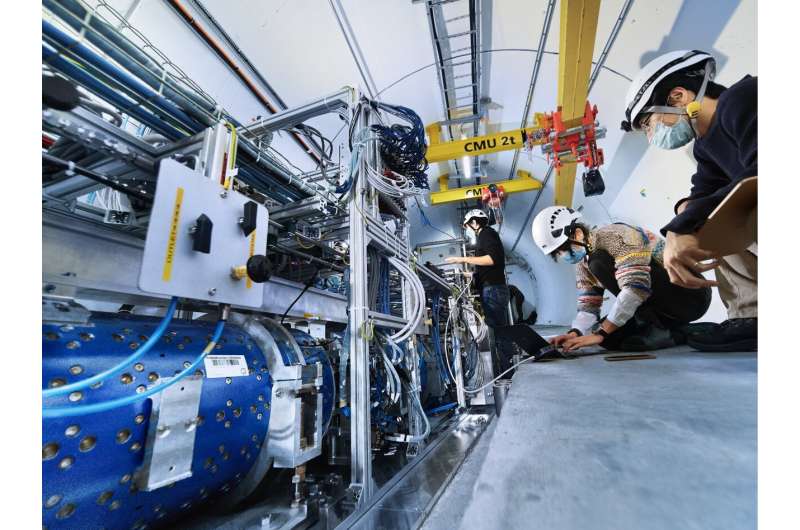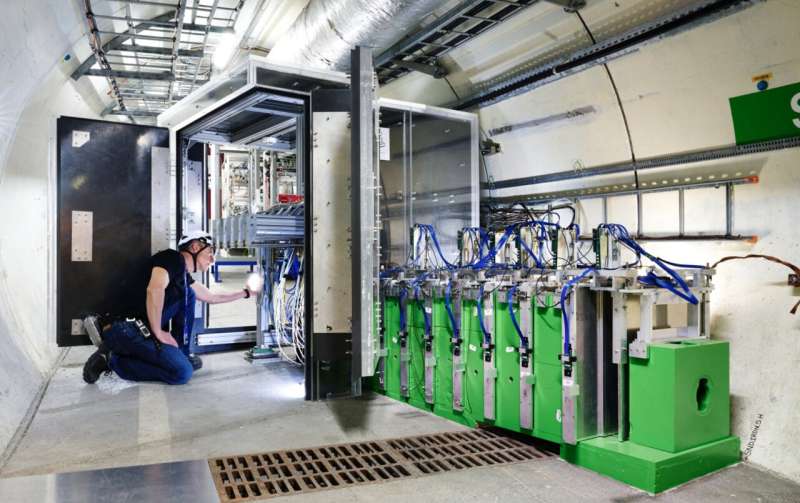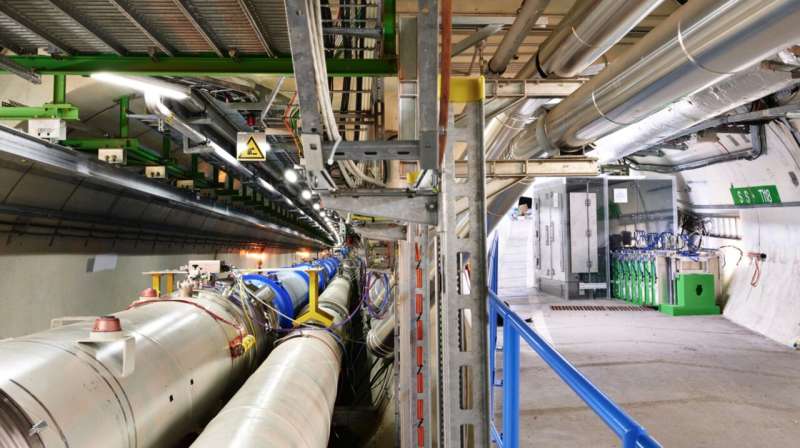August 26, 2023 feature
This article has been reviewed according to Science X's editorial process and policies. Editors have highlighted the following attributes while ensuring the content's credibility:
fact-checked
peer-reviewed publication
trusted source
proofread
The first observation of neutrinos at CERN's Large Hadron Collider

Neutrinos are tiny and neutrally charged particles accounted for by the Standard Model of particle physics. While they are estimated to be some of the most abundant particles in the universe, observing them has so far proved to be highly challenging, as the probability that they will interact with other matter is low.
To detect these particles, physicists have been using detectors and advanced equipment to examine known sources of neutrinos. Their efforts ultimately led to the observation of neutrinos originating from the sun, cosmic rays, supernovae and other cosmic objects, as well as particle accelerators and nuclear reactors.
A long-standing goal in this field of study was to observe neutrinos inside colliders, particle accelerators in which two beams of particles collide with each other. Two large research collaborations, namely FASER (Forward Search Experiment) and SND (Scattering and Neutrino Detector)@LHC, have observed these collider neutrinos for the very first time, using detectors located at CERN's Large Hadron Collider (LHC) in Switzerland. The results of their two studies were recently published in Physical Review Letters.
"Neutrinos are produced very abundantly in proton colliders such as the LHC," Cristovao Vilela, part of the SND@LHC Collaboration, told Phys.org. "However, up to now, these neutrinos had never been directly observed. The very weak interaction of neutrinos with other particles makes their detection very challenging and because of this they are the least well studied particles in the Standard Model of particle physics."
The FASER and SND@LHC collaboration are two distinct research efforts, both utilizing the LHC at CERN. Recently, these two efforts independently observed the first collider neutrinos, which could open important new avenues for experimental particle physics research.

The FASER collaboration is a large research effort established with the goal of observing light and weakly interacting particles. FASER was the first research group to observe neutrinos at the LHC, using the FASER detector, which is positioned over 400m away from the renowned ATLAS experiment, in a separate tunnel. FASER (and SND@LHC) observe neutrinos produced in the same "interaction region" inside the LHC as ATLAS.
"Particle colliders have existed for over 50 years, and have detected every known particle except for neutrinos," Jonathan Lee Feng, co-spokesperson of the FASER Collaboration, told Phys.org. "At the same time, every time neutrinos have been discovered from a new source, whether it is a nuclear reactor, the sun, the Earth, or supernovae, we have learned something extremely important about the universe. As part of our recent work, we set out to detect neutrinos produced at a particle collider for the first time."
The FASER collaboration observed collider neutrinos by placing their detector along the beam line, following their trajectories. High energy neutrinos are known to be predominantly produced at this site, but other detectors at LHC have blind spots in this direction and thus have not been able to observe them in the past.
"Because these neutrinos have high fluxes and high energies, which makes them far more likely to interact, we were able to detect 153 of them with a very small, inexpensive detector that was built in a very short time," Feng explained. "Previously, particle physics was thought to be divided into two parts: high energy experiments, which were required to study heavy particles, like top quarks and Higgs bosons, and high intensity experiments, which were required to study neutrinos. This work has shown that high energy experiments can also study neutrinos, and so has brought together the high-energy and high-intensity frontiers."
The neutrinos detected by Feng and the rest of the FASER collaboration have the highest energy ever recorded in a laboratory environment. They thus could pave the way for in-depth studies of the properties of neutrinos, as well as searches for other elusive particles.

Shortly after FASER reported the first observation of collider neutrinos, the SND@LHC collaboration finalized its analysis, with eight additional events in the LHC involving neutrinos. The SND@LHC experiment was specifically established to detect neutrinos, using a detector that is two meters in length, strategically placed at a site in the LHC where the flux of neutrinos is high, but shielded from proton collision debris by approximately 100 meters of concrete and rock.
"Even with its strategic positioning, the highest energy muons produced in the collisions reach our detector at a rate tens of millions of times higher than the interactions of neutrinos," Vilela explained. "These muons generate neutral hadrons in their interactions with the material surrounding our experiment, which in turn produce signals in the detector which are similar to those of neutrinos. Overcoming this background was the biggest challenge in the analysis, which made use of the distinctive pattern of a muon track associated to a hadronic shower and no charged particles entering the detector to identify the neutrino interactions."
As part of their recent study, the SND@LHC collaboration analyzed data collected by their detector between July and November 2022, which was its first operation cycle. This first data collection run was found to be highly successful, as the team ultimately recorded 95% of the collision data delivered to them and ultimately observed collider neutrino events.
"The observation of collider neutrinos opens the door to novel measurements which will help us understand some of the more fundamental puzzles of the Standard Model of particle physics, such as why there are three generations of matter particles (fermions) that seem to be exact copies of each other in all aspects except for their mass," Vilela said. "Furthermore, our detector is placed in a location which is a blind spot for the larger LHC experiments. Because of this, our measurements will also contribute to a better understanding of the structure of colliding protons."
These recent studies by the FASER and SND@LHC collaborations contribute significantly to ongoing experimental particle physics research and could soon pave the way for further breakthroughs in the field. Now that the presence of neutrinos at the LHC has been confirmed, these two experiments will continue collecting data, potentially leading to more meaningful observations.
"We will be running the FASER detector for many more years, and expect to collect at least 10 times more data," Feng added. "A particularly exciting fact is that this initial discovery only used part of the detector. In the coming years, we will be able to use the full power of FASER to map out these high energy neutrino interactions in exquisite detail. In addition, we are working on the Forward Physics Facility, a proposal to build a new underground cavern at the LHC, which will allow us to detect millions of high-energy neutrinos, as well as search for milli-charged particles and other phenomena associated with dark matter."
More information: Henso Abreu et al, First Direct Observation of Collider Neutrinos with FASER at the LHC, Physical Review Letters (2023). DOI: 10.1103/PhysRevLett.131.031801
R. Albanese et al, Observation of Collider Muon Neutrinos with the SND@LHC Experiment, Physical Review Letters (2023). DOI: 10.1103/PhysRevLett.131.031802
Journal information: Physical Review Letters
© 2023 Science X Network





















